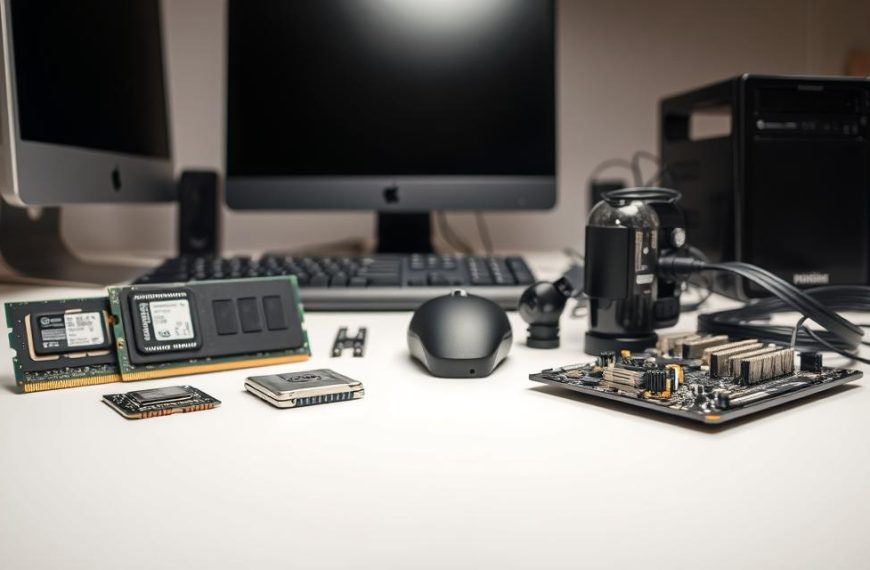When technology fails, every moment is precious. Both organisations and individuals face big problems when their digital systems crash. It’s key to know how to check if your system status is okay to keep things running smoothly.
Today, fixing problems often means using cloud-based solutions. Many people use their Microsoft account to get back up and running after a crash. This shows that your computer systems operational status is getting back to normal.
Checking if your system is working right away helps avoid losing data and cuts down on downtime. The next parts will show you how to check if your equipment is back up and running well.
Understanding System Status and Downtime Indicators
When computer systems face disruptions, it’s key to spot the exact problem for quick fixes. Different downtime indicators show up in various ways. Each one points to a specific issue needing a unique solution.
What Constitutes System Downtime
System downtime means any time a computer system or network is down. Companies sort these issues by their cause and how serious they are.
Planned vs unplanned outages
Planned outages happen when systems are shut down for updates or repairs. These are planned ahead to lessen disruption.
Unplanned outages, on the other hand, are sudden. They can be due to crashes, power cuts, or security issues. They need quick action and often start emergency plans.
Partial vs complete system failure
Partial failures hit certain parts of a system but not all. For instance, a database server might fail while web servers keep working.
Complete failures, though, shut down everything. This usually comes from big problems like power grid issues or major network failures.
Common Signs Your Systems Are Offline
Spotting early signs helps fix problems before they get worse. There are clear signs that systems are struggling.
Error messages and connection timeouts
Users might see error codes like “HTTP 500” or “Connection Timed Out”. Browser problems, like JavaScript errors or failed API calls, often point to network issues.
Application responsiveness issues
Apps might slow down, freeze, or not load. These signs often mean a bigger problem is coming and need quick action.
“Modern monitoring systems can detect responsiveness issues before users notice them, allowing proactive resolution.”
Different Types of System Outages
Knowing about system outage types helps plan better recovery strategies. Each type needs a different way to diagnose and fix.
Network connectivity problems
These issues can be from local network mistakes to big internet failures. They might show as DNS problems, packet loss, or no internet access.
Good observability practices help tell apart local network issues from bigger internet problems.
Server and infrastructure failures
Hardware or software problems can make servers stop working. Storage failures and memory leaks are common causes of downtime.
Even when the infrastructure looks fine, apps can fail. This needs careful monitoring across all system layers.
Immediate Checks: Are the Computer Systems Back Up
When systems seem unresponsive, quick checks can tell if they’re working. These tests help find out if the problem is just local or if it’s bigger.
Testing Basic Network Connectivity
Start your network connectivity test by looking at basic network settings. This shows if your device is talking to the network right.
Using ipconfig and ifconfig commands
Windows users should open Command Prompt and type “ipconfig”. This shows IP address, subnet mask, and default gateway info. Linux and macOS use “ifconfig” for similar details.
Checking network adapter status
In Windows, go to Network Connections to check adapter status. Green lights mean you’re connected. For all systems, make sure network cables are tight and router lights are normal.
Verifying Local System Status
Proper local system verification checks if core services are working right before looking at outside factors.
Windows Services console check
Press Windows Key + R, type “services.msc”, and look at key services. Make sure DHCP Client and Network Connections are running. Services set to start automatically should not be stopped unless you meant to.
Unix/Linux service status commands
Use “systemctl status service-name” or “service service-name status” to check important daemons. NetworkManager, sshd, and other key services should be active without errors in their logs.
Checking Internet Access and External Connections
After checking local systems, test if you can connect to the internet. This helps find if the problem is with your internet or DNS.
Testing DNS resolution
Try “nslookup google.com” or “dig google.com” to test DNS. If it works, it means domain name resolution is fine. But if it fails, it might be DNS setup or provider issues.
Verifying gateway connectivity
Ping your default gateway using the address from ipconfig/ifconfig. If it pings successfully, your local network is good. But if it fails, it could be a router problem or a local network setup issue.
Using Built-in System Monitoring Tools
Modern operating systems have powerful tools to check your computer’s health. These system monitoring tools give you a detailed look at how your hardware and software are doing. You don’t need to download anything extra to use them.
Windows Task Manager and Resource Monitor
Windows has two key tools for checking your system. Task Manager shows you what’s running and how much resources it’s using. Resource Monitor gives you even more detailed info.
CPU and Memory Utilisation Analysis
In Task Manager’s Performance tab, you can see how much CPU and memory are being used. It helps you spot any processes that are using too much. Resource Monitor also shows more about memory and CPU use.
Disk and Network Performance Metrics
Task Manager lets you check disk activity and network use. You can see how fast data is being read and written, and how much bandwidth is being used. Windows Security’s report also checks storage, battery, and app health.
macOS Activity Monitor and Console
macOS has strong tools for monitoring your system. They help you understand how your system is working and find problems.
Process Monitoring and System Diagnostics
Activity Monitor shows CPU, memory, energy, disk, and network use for all running apps. The Energy tab helps find apps that use a lot of battery. The Disk tab shows disk activity.
Log Analysis for Error Detection
Console.app collects logs from different parts of your system. It lets you track errors and system events. You can filter logs to find specific issues.
Linux System Monitoring Commands
Linux has powerful command-line tools for monitoring your system. They give you detailed insights and help you diagnose problems.
Top, htop, and vmstat Usage
The ‘top’ command shows what’s happening with your system in real-time. ‘htop’ has a better interface with colour-coded performance metrics. ‘vmstat’ gives info on memory, processes, and CPU.
System Log Analysis with journalctl
journalctl lets you search systemd journal logs. You can filter by time, service, or priority. It’s great for finding and fixing problems by looking at events in order.
Checking Enterprise System Status Pages
Enterprise status pages are key for checking system availability. They offer real-time service info. These portals give clear updates during outages and maintenance.
Microsoft 365 Service Status Portal
Microsoft’s service health dashboard gives a clear view of cloud services. Admins can see the status of all services quickly.
Accessing the admin centre status page
Go to admin.microsoft.com and log in with your admin details. Click Health > Service health from the left menu. The dashboard shows the current status of your services.
Interpreting service health indicators
Microsoft uses colours to show service health. Green means everything’s fine, yellow for notices, and red for incidents. Each service has details on incidents and when they’ll be fixed.
Google Workspace Status Dashboard
Google has a clear status dashboard for Workspace services. It offers real-time updates and past performance data for better decisions.
Navigating the Google status console
Visit status.cloud.google.com in any browser. The dashboard shows all Workspace services. You can filter by specific services or regions.
Understanding incident severity levels
Google has four severity levels for incidents. Outages mean no service, disruptions are partial issues. Delays are performance problems, and notices are for planned work.
Amazon AWS Service Health Dashboard
AWS has a detailed dashboard for service health. It’s vital for those using Amazon’s cloud.
Regional service status checking
The AWS Health Dashboard lets you filter by region and service. This helps spot local outages. Services are colour-coded for easy checking.
Historical outage information access
AWS keeps detailed records of past incidents. This archive helps understand causes and fixes. It’s useful for planning and avoiding future issues.
| Platform | Access URL | Key Features | Update Frequency |
|---|---|---|---|
| Microsoft 365 | admin.microsoft.com | Tenant-specific status, resolution timelines | Real-time |
| Google Workspace | status.cloud.google.com | Multi-service view, severity levels | 5-minute intervals |
| Amazon AWS | status.aws.amazon.com | Regional filtering, historical data | Continuous |
These status pages are key during service issues. Keeping an eye on them helps stay on top of system issues and respond well.
Network Diagnostic Tools and Techniques
When basic checks don’t solve network problems, we need advanced tools. These help find out if issues are local, with internet providers, or with network parts. Good network diagnostics can save a lot of time.
Using Ping and Traceroute Commands
Ping and traceroute are key commands for network checks. Ping checks if devices can connect, while traceroute shows the path data takes.
Basic connectivity testing methodology
Start with ping tests on your local network. Then, test the internet with ping 8.8.8.8. Use tracert on Windows or traceroute on Unix to find connection problems.
Interpreting latency and packet loss results
Latency under 100ms is good. But, packet loss over 1% means network issues. Knowing your network’s normal performance is key for latency interpretation.
Network Analysers and Monitoring Software
For detailed insights, use dedicated analysers. These tools look at each data packet in your network.
Wireshark for packet analysis
Wireshark is top for packet inspection. It’s free and works on many platforms. It shows protocol details and can spot odd traffic.
PRTG Network Monitor setup
PRTG monitors your network with sensors. It tracks bandwidth, availability, and performance. Set up by defining IP ranges and devices to watch. It alerts you to problems before they affect users.
Checking Router and Switch Status Lights
Looking at network hardware can find problems missed by software. Status lights show if devices are working right.
Interpreting LED indicator patterns
Green lights mean everything’s fine. Amber might mean performance is down. Blinking lights show data is moving. Fast blinking could mean network problems.
Cisco and HP network equipment diagnostics
Cisco devices have mode buttons for status info. HP gear has colour LEDs for quick checks. Check the manual for what each light means.
Cloud Service Status Verification
Verifying the status of cloud services is key for businesses to keep running smoothly. Today’s companies rely a lot on cloud systems. So, knowing how to check cloud status verification is vital for IT teams.
Microsoft Azure Status Check
Microsoft Azure has great tools for keeping an eye on service uptime. The Azure Service Health portal gives you live updates on how your cloud setup is doing.
Azure Service Health portal navigation
You can find the Azure Service Health portal in your Azure account dashboard. It shows any current issues, planned maintenance, and health alerts. You can filter by region and service type for better monitoring.
Resource health and availability monitoring
Azure’s resource health feature lets you see the status of your resources. This helps you figure out if the problem is with the platform or your setup. You can also set up alerts for when your resource health changes.
Google Cloud Platform Status
Google Cloud Platform has a clear status reporting system. Their dashboard gives detailed info on how all GCP products are doing.
GCP status dashboard utilisation
The GCP status dashboard uses colours to show service status quickly. Green means everything’s fine, while yellow and red mean there’s a problem. It also has historical data to spot recurring issues.
Service-specific status checking
For a closer look, you can check specific services like Compute Engine or Cloud Storage. Each service page has performance data, known issues, and when they’ll be fixed. This helps you pinpoint problems more easily.
Salesforce Trust Status Page
Salesforce uses Trust.salesforce.com as their main status page. It gives live updates on all Salesforce products and services.
Trust.salesforce.com access
You can get to the trust site without logging in, which is helpful during login problems. The main page shows the status of all Salesforce instances and services. You can also sign up for email or SMS alerts for status changes.
Performance and maintenance status
The performance section shows response times and latency across different regions. The maintenance status gives you notice of planned downtime. Historical reports help you spot patterns and prepare for future issues.
These service health portals are key for managing cloud-based systems well. Regular checks help you respond fast to any service problems.
Best Practices for System Status Monitoring
Proactive system monitoring changes how organisations deal with disruptions. It ensures quick detection and response to issues before they get worse.
Setting Up Automated Monitoring Alerts
Effective automated monitoring gives real-time insights into system health. Setting up alert systems helps teams act fast when problems arise.
Nagios and Zabbix configuration
Nagios and Zabbix are great for monitoring. To use them well, you need to:
- Define host groups and service checks
- Set up notification commands
- Configure escalation policies
- Implement dependency checks
Alert threshold best practices
Setting the right alert thresholds is key. It stops alert fatigue while keeping you informed. Here are some tips:
- Use multi-level thresholds for gradual escalation
- Implement hysteresis to avoid flapping alerts
- Set business-hour specific thresholds
- Regularly review and adjust thresholds based on historical data
Creating a System Status Checklist
A detailed checklist ensures consistent monitoring. It acts as a preventive measure and recovery guide.
Essential components to monitor regularly
Your checklist should cover these key areas:
- CPU and memory utilisation
- Disk space and I/O performance
- Network connectivity and bandwidth
- Application-specific metrics
- Database performance indicators
Documentation and reporting procedures
Good documentation is vital for monitoring and troubleshooting. Make sure to include backup steps in your recovery plans. This helps in quick system recovery during outages.
Establishing Communication Protocols During Outages
Good outage communication reduces business impact during disruptions. Clear protocols ensure everyone knows their role.
Incident response team coordination
Coordinate your team with these strategies:
- Define clear escalation paths
- Establish primary and secondary contacts
- Implement shift handover procedures
- Maintain updated contact information
Stakeholder communication strategies
Keep stakeholders informed with clear communication:
- Provide regular status updates
- Set realistic recovery time expectations
- Use multiple communication channels
- Document lessons learned after resolution
These best practices help maintain system health and ensure business continuity. They make monitoring and communication effective.
Conclusion
To check if computer systems are working, we need to use many methods. We start with quick network checks. Then, we look at big enterprise status sites like Microsoft 365 Service Status or Amazon AWS Service Health Dashboard. Each step helps us get a full picture of how systems are doing.
Keeping an eye on systems all the time helps us spot problems fast. Setting up alerts and clear ways to talk about issues is key. This way, we can manage systems well and keep businesses running smoothly.
Using both quick checks and big monitoring tools helps make systems reliable. This way, we can reduce downtime and keep our digital world running smoothly.



















